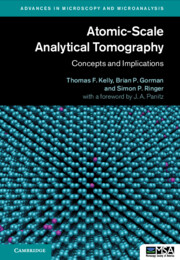Book contents
- Atomic-Scale Analytical Tomography
- Advances in Microscopy and Microanalysis
- Atomic-Scale Analytical Tomography
- Copyright page
- Dedication
- Contents
- Foreword
- Atomic-Scale Analytical Tomography (ASAT)
- Preface
- Acknowledgments
- Introductory Section
- Core Section
- 4 Has ASAT Been Achieved?
- 5 How ASAT Might Be Achieved
- 6 Instrumentation for ASAT
- 7 Practical ASAT
- 8 Toward Real-Space Crystallography
- 9 Experimental Metrics for ASAT
- Implications Section
- Index
- References
4 - Has ASAT Been Achieved?
from Core Section
Published online by Cambridge University Press: 03 March 2022
- Atomic-Scale Analytical Tomography
- Advances in Microscopy and Microanalysis
- Atomic-Scale Analytical Tomography
- Copyright page
- Dedication
- Contents
- Foreword
- Atomic-Scale Analytical Tomography (ASAT)
- Preface
- Acknowledgments
- Introductory Section
- Core Section
- 4 Has ASAT Been Achieved?
- 5 How ASAT Might Be Achieved
- 6 Instrumentation for ASAT
- 7 Practical ASAT
- 8 Toward Real-Space Crystallography
- 9 Experimental Metrics for ASAT
- Implications Section
- Index
- References
Summary
Using our strict definition of Atomic Scale Analytical Tomography (ASAT), we explore the current landscape of materials characterization tools and discuss how electron microscopy, field ion microscopy, and atom probe tomography are each approaching ASAT. State-of-the-art electron microscopy can achieve sub-angstrom spatial resolution imaging in 2-D and small volumes in 3-D but lacks single-atom chemical sensitivity, especially in 3-D. Field Ion Microscopy can achieve 3-D imaging on small volumes but not for all materials. Atom probe tomography can achieve single-atom elemental quantification in 3-D but lacks the spatial resolution necessary for ASAT. The chapter concludes with a comparison of the different techniques and discusses how different techniques may be complementary.
Keywords
- Type
- Chapter
- Information
- Atomic-Scale Analytical TomographyConcepts and Implications, pp. 55 - 76Publisher: Cambridge University PressPrint publication year: 2022



